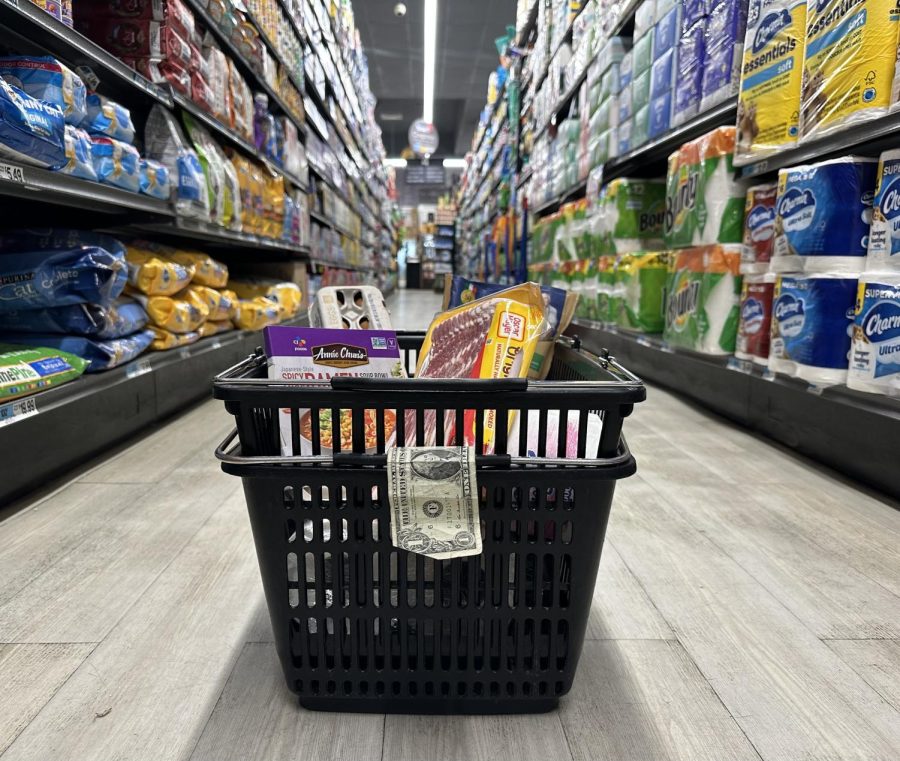Rising Inflation Rate Affects Prices in NYC
The current rate of inflation in New York City is 6%, three times the Federal Reserve’s acceptable target of 2%
Food prices in NYC have increased up to 8.4%, a change that has impacted students.
March 24, 2023
Three years have passed since the outbreak of the COVID-19 pandemic, yet inflation rates continue to rise. In New York City, which was ranked the most expensive city in the world for the first time in 2022, the high cost of living is cited as a source of concern for many members of the Fordham community.
According to the Bureau of Labor Statistics the national inflation rate was 6.4% as of February 2023, and, according to The City, the rate in New York City was 6.0%, meaning that prices in NYC increased by 6.0% from Jan. 2022 to Jan. 2023. The data for the March 2023 consumer price index (CPI), which is used to measure the inflation rate, will be released on April 12.
Giacomo Santangelo, professor of economics at Fordham, explained several key reasons as to why inflation remains at a high rate. He explained that there are issues contributing to the upward pressure on consumer prices citing the labor market, pressure on wages, lingering effects of supply-chain issues as well as the accumulation of years of malinvestment due to Federal Reserve policy.
According to the Federal Reserve, the inflation target rate should normally be around 2% to ensure stable prices in the U.S. economy; the last time the rate was at that target occurred in February 2021 when it was 1.7%. Since then, the rate has jumped to 9.1% in June 2022, the highest rate in over forty years.
Santangelo also noted that the primary cause inflation remains at a high rate is due to the Federal Reserve and the Congressional Budget Office’s overstimulation of the economy in an effort to avoid a longer recession during the COVID-19 pandemic.
According to the Federal Reserve, the inflation target rate should normally be around 2% to ensure stable prices in the U.S. economy; the last time the rate was at that target occurred in February 2021 when it was 1.7%. Since then, the rate has jumped to 9.1% in June 2022, the highest rate in over forty years.
Food costs are one factor affected by rising inflation costs. For example, food prices soared to 7.8% toward the end of last month with several grocery items such as eggs costing at an average of $4.20, more than twice what they cost two years ago.
Maria Komiyama, Fordham College at Lincoln Center (FCLC) ’24 and a resident in McMahon Hall, said that she prefers to buy her groceries because meal plans are too “expensive.”
Meal plan rates at Lincoln Center differ depending on the amount of meal swipes, dining dollars and the total number of meals that can be used at retail locations for meal exchanges. The two basic meal plans offered are the Block 100 and the Block 100 Plus plans, both of which offer 100 meal swipes and up to 100 meal swipes that can be exchanged per academic year. The plus plan differs in that it offers $400 dining dollars for a total of $1,680 compared to the Block 100 plan offering $200 in dining dollars for a total of $1,490.
The total cost of education at Fordham has increased by 4% from the 2022-23 academic year under former University President Joseph M. McShane, S.J., and will be raised again in the 2023-24 academic year at an unannounced rate, according to University President Tania Tetlow, J.D.
Komiyama added that now, when she goes grocery shopping, she has noticed some of the changes in prices of even the most typical inexpensive staples.
“What’s so crazy is like, you would think ramen is cheap, but ramen is not cheap in the city for some reason,” she said, providing the example of a ramen cup costing $3-4. Instant ramen noodles, such as the Maruchan or Nissin Top Ramen brands, range from 0.45 cents to $1.49, and some brands, such as Momofuku, are sold in five count bundles for $11.99 coming out to $2.40 noodle package.
Kamila Carpio, FCLC ’24 and president of the Commuting Student’s Association, said she thinks more about her budget before making any food purchases, as she pays around $700 of tuition per month compared to paying $300 at the beginning of her freshman year. The total cost of education at Fordham has increased by 4% from the 2022-23 academic year under former University President Joseph M. McShane, S.J., and will be raised again in the 2023-24 academic year at an unannounced rate, according to University President Tania Tetlow, J.D.
Inflation has also hit the New York City real estate market, impacting some students’ ability to find affordable off-campus housing.
She added that she also pays $250 for gas and $200 for insurance per month in order to drive from her home in Queens to Fordham. Gas prices are another factor of inflation, as they are expected to be about $3.49 a gallon this year, a 55 cent drop from last year’s record high price of $3.96 per gallon.
“The costs just keep adding up,” Carpio said.
Inflation has also hit the New York City real estate market, impacting some students’ ability to find affordable off-campus housing. Manhattan’s median monthly rent is at an all-time high of $3,275, or $84 per square feet for a studio apartment compared to a year ago where the rent cost $2,869. At the Lincoln Center campus, single-occupancy bedrooms are only offered in McMahon Hall and cost $21,945 per academic year or approximately $2,438.33 per month for rent from September to May for access to a single bedroom, bathroom, living space and kitchen.
“Even small studios can cost a fortune to rent which has made me consider moving out of Manhattan.” Konstantin Perfilliev, FCLC ’24
According to the NYC Housing Preservation and Development, housing is considered affordable if it costs one-third of an individual’s salary. Currently, the minimum living wage rate in New York City is $15 and individuals are considered to be making a moderate income if they make at least $74,720, or nearly 81% of the area median income which is used to measure income eligibility and rent for City-financed affordable housing projects.
Konstantin Perfilliev, FCLC ’24, said he was considering living alone next year but could not find an apartment in Manhattan that was lower than the costs of dorms.
“Even small studios can cost a fortune to rent which has made me consider moving out of Manhattan,” he said.
Inflation can also have an impact on the mental and physical health of students. Komiyama said that the lowest point of her life was in her sophomore year where she was working long hours to make money, but at the same time, feeling “stressed and detached from social life.”
“I lost a lot of weight that year, and I feel like my social skills also suffered as a result of this,” she said about the cost of living. “It’s kind of like a domino effect.”
Perfilliev said that he is concerned about his long-term career path, including prospects of entering the workforce and becoming financially stable after graduation.
“With how competitive the labor market and expensive sustaining a good quality of life in New York City is, this makes it feel as if the stakes are much higher,” he said.
Although recent data from The New York Times has shown that inflation rates have slightly cooled since they peaked in 2022, it also revealed that the numbers are still climbing rapidly. In a policy meeting on Dec. 14, 2022, Jerome Power, chair of the Federal Reserve, analyzed the downward inflation trends toward the conclusion of 2022 and considered the future of the CPI.
“It’s good to see progress but let’s just understand we have a long way to go to get back to price stability,’’ Powell said.











